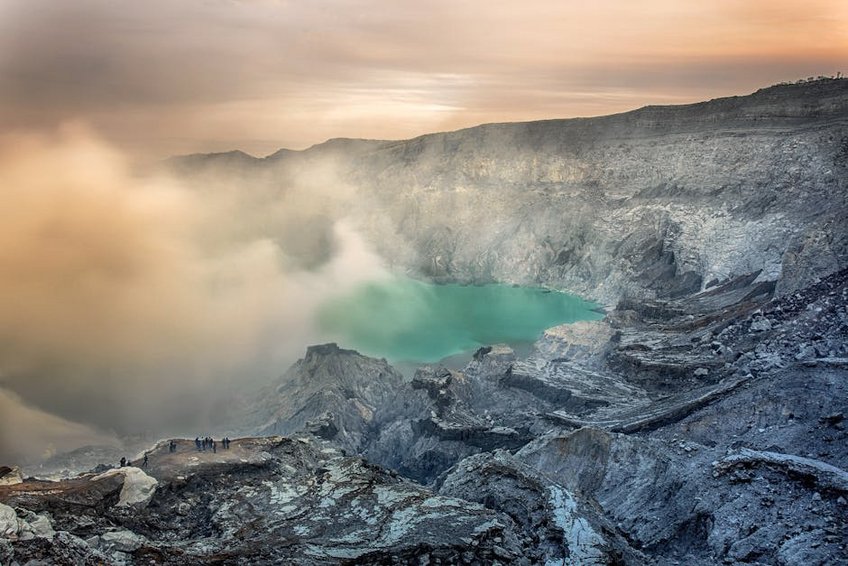Tbilisi Sulfur Baths
Stepping into the Tbilisi Sulfur Baths feels like entering a different world, one where time slows down and relaxation takes center stage. Nestled in the Abanotubani district, these iconic domed structures have been the heart and soul of Georgia’s capital for centuries, offering both locals and travelers a unique cultural experience that blends wellness with tradition. The moment you catch that distinctive sulfur scent in the air, you know you’re about to experience something truly special. These baths aren’t just about getting clean—they’re about immersing yourself in Georgian culture, connecting with history, and emerging rejuvenated both physically and mentally. Whether you’re seeking relief from travel fatigue or simply want to experience an authentic piece of Tbilisi, the sulfur baths deliver an unforgettable journey through Georgia’s bathing traditions that will leave you feeling completely transformed.
Tbilisi Sulfur Baths Essential Information
Understanding the basics of Tbilisi Sulfur Baths will significantly enhance your experience in this unique thermal complex. The baths derive their healing properties from naturally heated sulfur waters that emerge at temperatures between 38-40°C (100-104°F), rich with minerals that have been valued for their therapeutic qualities since ancient times. The distinctive egg-like smell comes from hydrogen sulfide, which might surprise you at first but quickly becomes part of the authentic experience. The bath district, known as Abanotubani, features beautiful brick domes that create a picturesque landscape, especially beautiful during golden hour when steam rises mystically from the vents. Most baths operate from early morning until late evening, with peak hours typically in the late afternoon when locals visit after work. The complex includes both public sections with separate gender areas and private rooms that can be booked for couples, families, or individual relaxation sessions.
Historical Significance – What You Need to Know
- The baths date back to the 5th century when King Vakhtang Gorgasali discovered the hot springs during a hunting trip, leading to Tbilisi’s foundation (Tbilisi means “warm location” in Georgian)
- Persian architectural influences are evident in the domed structures, reflecting centuries of cultural exchange along the Silk Road trading routes
- Famous historical figures including Alexander Dumas and Alexander Pushkin visited and wrote about their experiences in these legendary baths
- Budget option: Public bath access costs approximately $5-10 USD per person including basic locker facilities, with additional small fees for towels and simple treatments
- Mid-range experience: Private rooms for 1-2 people range from $30-60 USD per hour, typically including a private pool, changing area, and basic amenities
- Luxury treatment: Premium packages with kisa (scrub) massage, herbal teas, and extended time can reach $80-150 USD for two people with multiple services
- Official Georgian Tourism Administration – Sulfur Baths Information
- Lonely Planet – Tbilisi Sulfur Baths Guide
Health Benefits and Mineral Properties
The sulfur-rich waters contain a remarkable combination of minerals including sulfate, calcium, magnesium, and bicarbonate that provide numerous therapeutic benefits. Regular bathers report relief from skin conditions like psoriasis and eczema, improved joint mobility for arthritis sufferers, reduced muscle tension, and overall stress relief. The warm water helps improve blood circulation while the mineral absorption through the skin can detoxify the body. Many visitors with respiratory issues find the steam particularly beneficial, as the sulfur compounds can help clear sinus passages and improve breathing. The experience combines physical wellness with mental relaxation, creating a holistic healing environment that has attracted wellness seekers for generations.
Tbilisi Sulfur Baths Planning Your Trip
Proper planning ensures you make the most of your Tbilisi Sulfur Baths experience without any unexpected surprises. The bath district is conveniently located in the historic Old Town, just a 10-15 minute walk from Liberty Square and easily accessible by metro (station: Avlabari). Most international visitors don’t require visas for Georgia (check your specific nationality requirements), and the baths are affordable compared to Western spa experiences. You’ll want to allocate 2-3 hours for a proper bath experience, including relaxation time before and after your treatment. Booking private rooms in advance is highly recommended during peak season (May-September) and on weekends, as these popular facilities can get fully booked. Remember to bring minimal valuables as lockers are provided but space is limited, and consider visiting during off-peak hours (mornings or weekdays) for a more tranquil experience without crowds.
Best Time to Visit Tbilisi Sulfur Baths
The sulfur baths offer unique experiences across different seasons, each with its own advantages. Spring (April-May) provides comfortable temperatures and blooming scenery around the bath district, while autumn (September-October) offers crisp air that makes the warm waters particularly inviting. Summer months can be hot in Tbilisi, making the baths more appealing in the evening when temperatures cool down. Winter visits are magical as steam rises dramatically against the cold air, creating an almost mystical atmosphere. For the best overall experience, consider visiting during shoulder seasons (April-May or September-October) when tourist crowds are smaller but weather remains pleasant. Weekdays generally see fewer visitors than weekends, and morning sessions (9 AM-12 PM) tend to be quieter than afternoon and evening slots when locals finish work.
Budget Planning and Costs
Essential Preparation Checklist
Preparing properly for your sulfur bath experience will maximize your comfort and enjoyment. Pack a swimsuit (though some locals traditionally bathe nude in gender-segregated areas, most tourists wear swimwear), flip-flops for walking around wet areas, and a change of clothes. While towels are usually available for rent, bringing your own might save a few dollars and ensure quality. Remove jewelry before entering as sulfur can tarnish certain metals. Hydrate well before and after your bath session since the heat can be dehydrating. If you have sensitive skin or medical conditions, consult with bath attendants about appropriate duration—start with 15-20 minute sessions initially. Don’t schedule tight activities afterward as you’ll want time to relax and enjoy the post-bath glow that typically lasts for hours.

Tbilisi Sulfur Baths Top Attractions and Activities
Beyond the basic bathing experience, the sulfur bath district offers numerous attractions and activities that create a comprehensive cultural journey. The most photogenic bathhouse is arguably the Orbeliani Bath with its beautiful blue-tiled facade and ornate Moorish architecture that makes it Instagram-famous. Nearby, you’ll find the charming Legvtakhevi Canyon with its waterfall just a short walk from the baths, perfect for a pre or post-bath stroll. The area surrounding the baths is filled with traditional Georgian restaurants where you can enjoy authentic khinkali (dumplings) and khachapuri (cheese bread) to complete your cultural experience. Many visitors combine their bath visit with exploration of the Narikala Fortress which overlooks the bath district, providing spectacular views of the domed structures from above. The sulfur bath experience itself typically involves alternating between hot pools, cool plunges (for the brave), and relaxation rooms where you can sip traditional herbal tea.
Must-See Highlights
Your Tbilisi Sulfur Baths experience should include several key highlights to make it truly memorable. The kisa massage treatment is an essential component—a vigorous exfoliating scrub using a special wool mitt that leaves your skin incredibly smooth and rejuvenated. Each bathhouse has its own character, so consider visiting multiple establishments; the historic Royal Bath dates back centuries while more modern facilities offer contemporary comforts. Don’t miss the chance to simply sit in the relaxation areas between dips, absorbing the atmosphere and watching the steam rise against the ancient brickwork. The exterior of the bath district is particularly photogenic at dusk when the domes are illuminated, creating a magical atmosphere. For history enthusiasts, some baths display historical photographs and artifacts that tell the story of this unique quarter through the ages.
Hidden Gems and Local Favorites
Beyond the main tourist attractions, several lesser-known experiences can make your sulfur bath visit extra special. The small sulfur spring fountain near the entrance to the district where locals sometimes fill bottles with drinking water believed to have digestive benefits. The hidden courtyard behind the main bathhouses features traditional Georgian seating areas where you can relax away from the crowds. Local residents often visit the public baths in the early morning hours (6-8 AM) for the most authentic experience—if you’re an early riser, joining them provides fascinating cultural insight. Some bathhouses offer traditional Georgian healing treatments using local herbs and techniques passed down through generations. For a unique perspective, walk up to the nearby Metekhi Church which offers stunning views down onto the bath district, especially beautiful when steam rises from multiple domes simultaneously.
Tbilisi Sulfur Baths Practical Travel Information
Navigating the practical aspects of visiting the sulfur baths requires understanding local customs, transportation options, and facility specifics. The bath district is located at the foot of Narikala Fortress in the Old Town, easily recognizable by its distinctive domed structures. Most bathhouses accept both cash (Georgian Lari) and credit cards, though having some local currency is recommended for small purchases and tips. English is spoken at most establishments catering to tourists, but learning a few basic Georgian phrases (hello: “gamarjoba,” thank you: “madloba”) will be appreciated. The water temperature in different pools varies—typically there are hot, warm, and cool options to alternate between. Facilities usually provide lockers, towels (sometimes for a small fee), and basic toiletries, though bringing your own preferred products might enhance your experience. Remember that photography rules vary by establishment—always ask permission before taking pictures, especially in common areas where other bathers might be present.
| Service Category | Options/Features | Price Range (USD) |
|---|---|---|
| Public Bath Access | Gender-segregated areas, shared pools, basic facilities | $5-10 per person |
| Private Room (1-2 people) | Private pool, changing area, sitting space, 1 hour minimum | $30-60 per hour |
| Additional Services | Kisa massage, herbal treatments, tea service, extended time | $10-40 per service |


